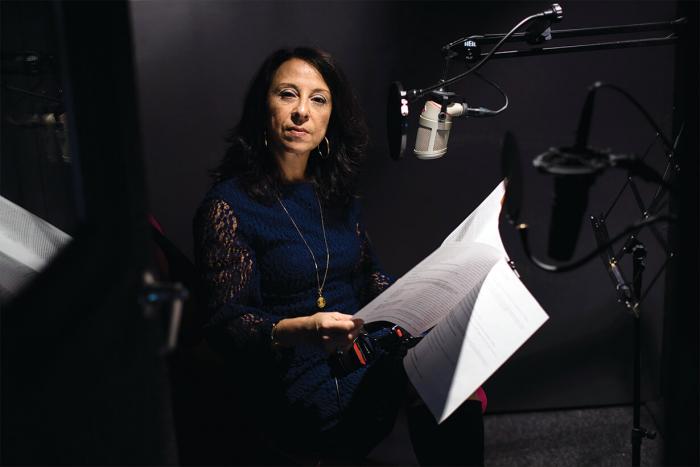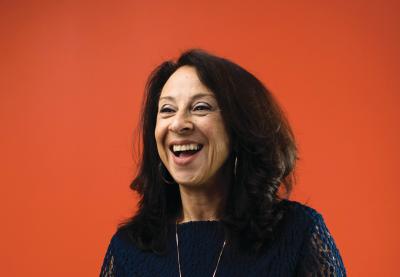If you’ve ever tuned into National Public Radio’s Latino USA, you’ve undoubtedly heard Maria Hinojosa’s warm, engaging voice reporting on lived experiences in Latino communities. Over her three-decade career as an anchor, journalist, producer, professor and founder of the Futuro Media Group, Hinojosa has lent her famous voice to countless everyday people who would not otherwise be heard. She spoke with Teaching Tolerance about breaking barriers as a Latina, telling untold stories and empowering the next generation.
In your recent TEDx Talk, you mention being very interested in the media as a child but not considering journalism as a career because you didn’t see your identity reflected in the media. How did you ultimately decide to go into broadcast journalism?
I [did] college radio at Columbia University. That was my first entrée, but I guess because it was college radio—it was kind of free form, it was live—I didn’t really think of myself as a journalist.
After doing my college radio show for a couple of years, I ended up meeting several Mexican women journalists. … They were covering the big story of the day, which was Central America. … [T]hen I had a visual. I saw these Mexican women, modern women, being independent, being fearless, covering these breaking stories in war zones. That was the thing that made me realize we do exist as an entity—just not in the United States.
The truth is that, even once I was ready to graduate, I had not practiced as a journalist yet. … It was a career counselor at my college who basically said, “You must apply to NPR for an internship, you have to.” I was like, “No, I’ll never get it.” So that’s funny how there are people who might be incredibly different from you—and maybe not even in the same field—who ultimately encourage you. That’s how my story basically happened.
Once I got to NPR, I understood that I had this opportunity so I needed to use it. … The thing that actually kept me going was this tremendous sense of responsibility because I was the first Latina hired at NPR who wasn’t, like, the cleaning staff. That was a big encouragement, me telling myself, “There’s nobody who understands this community the way you do, you’ve got to stay there, you’ve got to raise your hand!” … I think that made me very authentic. I was always in touch at the grassroots level. “What’s going on?” “What are people saying?” “What are they thinking?” That allowed me to come into the newsroom and propose story ideas that were based on real life. That is how I encouraged myself not to give up even though I felt like a fish out of water a lot of the time.
You often focus your journalistic lens on untold stories. What untold stories do you think students and educators in public schools should seek out and be exposed to?
It’s weird because you’re asking me what do I think educators need to know, and there is almost a response that says, for the educators across the country, “Look at your student body. Look at them for the stories that need to be told.”
I’m going to give you an example. One in four Latinos knows someone who has been detained or deported. One in three Latinos worries that someone they know could be detained or deported. If you just start from that jumping-off point—I’m thinking about the number of kids who come into school who are dealing with a family separation. Where their father was picked up at six o’clock in the morning and is gone and is in the detention center and now is being processed for deportation. This student who is actually living through this doesn’t have the capacity to come in and say to the class, to the teacher, “Let me tell you what I’m living through.” In fact, in that inability to share that story, we’re not sharing American history as it’s happening right now. …
One of the things that I do with my students is I really make them talk and own their personal narrative. “What’s going on in your home?” “Why is that happening?” “How did it happen that you ended up here?” So that they learn to talk with agency about who they are. I’m always telling [my first-generation students], “You are American. This is an American experience. You are living and creating American history. You are the new pilgrims, the new pioneers. You are powerful actors in American history and you need to move in the world like that.” That’s what I tell them, because we want anyone who’s living in our county—whether or not they have citizenship, I don’t really care—we want them feeling empowered in a democracy. That’s ultimately what we want and that’s what I try to teach. Own your voice; own your agency; own your power.
What principles guide you in your journalistic work that you think would be useful to educators?
One of the guiding principles that I have is that, when anybody is speaking to me as a journalist, I really approach it from a place of humility, respect and gratitude. … I think that we can communicate that to our students, and show them respect for the life that they are leading, the challenges that they have.
There was a great lesson that I learned from my best friend who just passed away—may she rest in peace—a great journalist Cecilia Vaisman. … She also got her master’s in education. She was telling me, as I was becoming a college professor, “If you want your students to really open up to you, you have to really open up to them. That means showing your own vulnerabilities. That means if you’re going to ask them to put something on the table about … [their] experience, about what happened last week, then you have to be able—as a teacher—to tell them what happened to you.”
I know it’s risky, but it’s actually delivered for me tenfold. I think it’s hard from K to 12, but there are ways in which teachers can do that, and that humanizes them and allows the students to feel like they, too, can be vulnerable and share.

What inspired you to produce the PBS series America by the Numbers? What do you hope to accomplish with the show?
[B]ecause I am a Mexican-born woman, I am an immigrant, I’ve been an American citizen since I was 30, there’s always this sense I have some kind of agenda. … [T]hat ended up leading me to a show that is based on data that is irrefutable. Then it’s not about my political agenda; it’s simply about the data. That’s where the whole notion of America by the Numbers came from. …
I love to take the hard data but then to create the human complexity of the stories behind that data. Make our characters or participants human, complex, multi-layered. It’s not black and white, actually; there’s a lot of gray there. It’s often times in the gray when we find the similarities that we all share. It’s about great storytelling at a moment in history that our country is just changing in amazing ways.
What kind of feedback did you get from viewers?
My favorite fact from our numbers is that people stayed throughout the entire episode. You do minute-by-minute ratings, and you can see where people turn away. They didn’t. The majority of our shows they stayed watching the entire episode.
There were people in the business that were like, “How did you do that?” I think it’s because of the faces that we were putting on the air. I think it’s because of the way we were approaching these stories. I think it was the beauty that we tried to capture and the way our shows were shot.
Own your voice; own your agency; own your power.
A friend of mine who is now teaching high school journalism in a public school in Los Angeles, she was saying that sometimes she’ll show kids videos in class, and she was showing America by the Numbers. At first the kids were like, “Oh God, another television show. Lights out. Just get it over with.” Then, as the minutes went into our show, more students started putting down their phones, putting down their pens and actually watching. She said, “I think it’s because of the faces you were putting there. The students saw themselves; they saw people who look like them in every way shape or form.” That, to me, is the best love you can get, when you know that high school students are actually watching.

Can you tell me about a teacher who made a difference for you?
Mrs. Turner was my first African-American teacher, and she made me feel heard. She saw me. She made me feel visible. There was something in the way she approached me, her kind of gentleness that made me believe I was equal to everyone else when, in fact, I was a minority in that classroom. I was the only one in that classroom that was coming from a Spanish-speaking household. So I did feel like the other and an outsider. ...
She was my second-grade teacher, but I go back to her as pivotal in my life. … [I]t really began from just one teacher taking the time to make me feel like she heard and saw me and treated my parents with great respect too. She was very sweet and gentle with my parents, both of whom spoke with very thick accents. So that’s what I try to do with my own students, right? I try to do that thing where I’m looking straight at them, talking to them, touching them, hugging them, listening to them intently. That’s my way of paying it forward from what I learned from Mrs. Turner.
Online Exclusive Interview
Hinojosa hosted a radio show in college, but she still wasn’t confident that she belonged in the journalism world. In this clip from her interview, she explains what inspired her to apply at NPR.
America By The Numbers
“Behind every number, there’s a story.” This PBS documentary series reveals how dramatic changes in U.S. demographics are playing out in communities across the country. Each half-hour episode focuses on statistics related to population, health, education and consumer trends and explores how these data influence the shifting realities of “mainstream America.” Watch full episodes and access accompanying lessons from Teaching Tolerance.

Use this activity to teach students how to conduct interviews that amplify “voice” and tell untold stories.
